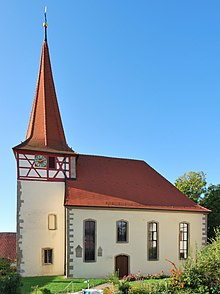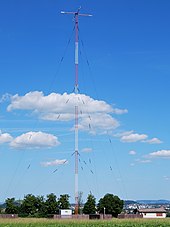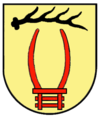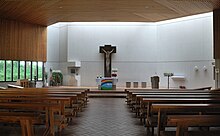Hirschlanden (Ditzingen)
|
Hirschlanden
City of Ditzingen
|
|
|---|---|
| Coordinates: 48 ° 50 ′ 15 ″ N , 9 ° 2 ′ 18 ″ E | |
| Height : | 333 m |
| Incorporation : | 1st January 1975 |
| Postal code : | 71254 |
| Area code : | 07156 |
Hirschlanden is a district of the city of Ditzingen in the Ludwigsburg district in Baden-Württemberg .
geography
Hirschlanden is located in the center of the Strohgau about two kilometers northwest of Ditzingen. Further neighboring towns and districts are Schöckingen in the north, Heimerdingen in the west, Höfingen in the south and Münchingen in the east. The gently sloping Hirschlander marking extends over an area of around 5 km in length in east-west and 1.5 km in width in north-south. The highest point is in the Steinbößle corridor in the west at approx. 400 m above sea level. NN, the deepest in the Glemstal at 285 m above sea level. NN. The church is located within the closed settlement at an altitude of around 335 m above sea level. NN.
history
Prehistory and early history
Hirschlanden can look back on several thousand years of settlement history. A well-known testimony is the Hallstatt Celtic grave stele of the warrior von Hirschlanden (also called the man of Hirschlanden ). It is dated to around 500 BC. BC and is the oldest life-size plastic representation of a person in Central Europe. The statue was found in 1963 on the edge of a Celtic burial mound that was almost completely leveled . In 2001 the burial mound was reconstructed with the help of a private sponsor and a copy of the statue was placed next to it. The original is in the Württemberg State Museum in Stuttgart.
The Hirschlander Markung is also where a number of other Celtic and Roman relics were found. A Roman manor was excavated in the Mäurach corridor north of Heimerdinger Strasse in 1853 on the western boundary of the marker . Roman finds also came to light in other places in the area.
middle Ages

Today's place was probably built between 720 and 750 as a Franconian expansion settlement between older Alemannic branches. The place name Hirschlanden is derived from the earlier cultivation of millet in the region. Hirschlanden is the oldest known place, the name of which ends in -landen. Together with neighboring Ditzingen, it was first mentioned in a document in 769 in a deed of donation to the Lorsch Abbey on Bergstrasse. Lantbold , presumably a Franconian landowner, bequeathed eight hubs in the village of Hirslande , four hubs in Ditzingen ( Tizingen ), as well as twelve arable men and eight people from his property in Glemsgau to the monastery . The copy of this deed of gift is in the Lorsch Codex . In 786, the church (presumably a private church of a Franconian landlord) was donated to the Lorsch monastery. With this, Lorsch Abbey initially also took on the spiritual care of Hirschlanden. Later the church and parts of the property fell to the Hirsau monastery and the Hirsau priory of Klosterreichenbach in the Murg Valley. The Hirsauer Pflege in Ditzingen, which was also known as “Pflege Hirschlanden” in the 17th and 18th centuries, took over the management and collection of the taxes .
Secular rule was held from around 1100 by the Counts of Calw , whose ownership passed to the Guelphs around 1132. Unlike in the neighboring communities Heimerdingen, Schöckingen, Höfingen and Ditzingen, a local noble family played no role. With the purchase of Glemsgau in 1308, the Count of Württemberg began to exert influence. In 1316 half of Hirschlanden was owned by Württemberg. The Württemberger initially competed with the gentlemen from Höfingen, Heimerdingen and Nippenburg , who also had property rights there. It was not until 1603 that Hirschlanden was entirely part of Württemberg.
Two other settlements were located on the current Hirschlander mark to the west of the current location: the hamlet of Holzheim and the Rotweil , which presumably emerged from a single farm, both of which fell desolate in the 15th century. Their tent division was still visible in the 19th century.
Modern times
In 1920 the farmer and former fighter pilot Emil Koch was elected mayor. During his tenure in 1922, the community was connected to the Strohgäu water supply. In 1929 the new school building (later the town hall building ) was inaugurated. In 1930 Koch was re-elected for life. In 1935, he also took over the role of mayor in the neighboring community of Schöckingen. Despite undeniable contributions to the development of the community, his work during the Third Reich is viewed critically in retrospect. As a member of the NSDAP (since 1933) he implemented the guidelines of the NS regime without criticism, organized the accommodation of forced laborers and prisoners of war and promoted the establishment of a labor camp for young women in Hirschlanden. In 1945 he was removed from office (successor as mayor in Hirschlanden was his brother Karl Koch), but re-elected in 1954.
Hirschlanden faced major challenges with the allocation of displaced persons. A housing committee organized the allocation of housing. The community made the former labor camp available as temporary accommodation. The number of inhabitants grew to 683 by the end of 1946. In view of the increasing demand for building land, the first reallocation of building land was initiated in 1949 in the west of the Ortsetter in Gewann Knäpple, the second in 1955 in the south-east of Gewann Unter im Dorf. In 1953/54 a new community hall was built. In 1955, work began on the local sewer system. In 1961 the first zoning plan was drawn up.
In 1962 Emil Koch resigned from office and was made an honorary citizen by the community. His successor was the later Lord Mayor of Ditzingen, Alfred Fögen , under whom the structural development of the community continued. In 1964/66, Hirschlanden and Schöckingen received a new schoolhouse (now Theodor Heuglin School), and in 1963 a kindergarten. In 1964 the community was connected to the Ditzingen / Stuttgart group sewage treatment plant. To ensure the water supply, Hirschlanden joined the Lake Constance Water Supply Association in 1965. In 1965 the volunteer fire brigade received a new fire station . A point of controversy developed into plans to build an own indoor swimming pool, which was not only rejected by the neighboring municipality of Ditzingen, but also recently by the district office and regional council.
In the 1960s, the municipality tried to raise the trade tax revenue, but not least, to attract industrial and commercial enterprises. Two industrial areas were designated in the garments of Lange Äcker and Hinterfeld , the latter on the edge of the existing Rombold & Gfröhrer quarry, primarily for emission-intensive companies. The address and data service provider Schober , the compressor center Albert Reinkunz, the precast concrete plant Götz KG, the Technische Federn Otto Joos GmbH and the electroplating institute Ernst Engelmann established themselves in the industrial area "Lange Äcker" .
In the course of the community reform initiated by the grand coalition under Hans Filbinger at the end of the 1960s , Hirschlanden had to give up its independence - against the will of citizens and local politics. A citizens' meeting on June 16, 1971, voted with an overwhelming majority in favor of maintaining independence. While the neighboring communities of Schöckingen and Heimerdingen were incorporated into Ditzingen in the same year, the mayor and council of Hirschlanden vehemently refused to merge. Under pressure from the state government, they ultimately had to give in. On June 12, 1974, the local council approved the unification agreement. On January 1, 1975, the Hirschlanden community merged with the city of Ditzingen to form the new city of Ditzingen.
Connections between Hirschlanden and Schöckingen
The geographical proximity of Hirschlanden and Schöckingen led to collaborations in several respects over the course of the 20th century: in administration (joint mayor, 1935–1945), in the school system (joint school since 1966), in the church sector (1938–1965 Protestant parish ; to this day the Catholic parish) and not least in associations. Several clubs chose both places as part of their name, such as the Hirschlanden-Schöckingen 1947 e. V. The grounds of the sports club, the Catholic church built in 1974 and the primary and secondary school are located on a hill between Hirschlanden and Schöckingen and can be easily reached on foot from both locations. Since there are no longer any shopping opportunities in Schöckingen, in 2005 a supermarket chain that was interested in the Hirschlanden location also built its branch on the hill between the two districts at the request of the local council.
religion
The Oswald Church in Hirschlanden has been Protestant since the Reformation was introduced in the county of Württemberg in 1534. In addition, there is now a Catholic parish (on the Holy Trinity, with Heimerdingen and Schöckingen) and an Evangelical Free Church parish.
politics
Hirschlanden has its own local council, which consists of eleven members. The head of the village is Barbara Radtke (CDU).
Mayor and mayor
Until the merger with the city of Ditzingen in 1975, the names of 25 mayors or mayors of the Hirschlanden community are known:
| Term of office | Surname |
|---|---|
| around 1600 | Jerg Mauch |
| + 1619 | Sebastian Heberlin |
| 1610-1632 | Georg Kuomen |
| 1633-1643 | Hans Ansel |
| 1643-1671 | Georg Schäfer |
| 1671-1695 | Jerg Flein |
| 1695-1722 | Hans Flein |
| 1722-1733 | Konrad Mann |
| 1733-1766 | Hans Jakob Linckh |
| 1766-1785 | Johann Jakob Linckh |
| 1785-1787 | Christian Benjamin Geisselin |
| 1787-1792 | Johann Konrad Feucht |
| 1792-1806 | Thomas Schäuffele |
| Term of office | Surname |
|---|---|
| 1806-1848 | Johann Konrad Mann |
| 1848-1872 | Johannes Hegele |
| 1872-1892 | Johann Georg Müller |
| 1892-1898 | Christian Konrad Müller |
| 1898-1913 | Gottlieb Grieshaber |
| 1913-1919 | Christian Gscheidle |
| 1919-1945 | Emil Koch |
| 1945 | Willy Kübler (acting) |
| 1945 | Friedrich Zeeb (Administrator) |
| 1945-1954 | Karl Koch |
| 1954-1952 | Emil Koch |
| 1962-1975 | Alfred Foegen |
Coat of arms and colors
Only since 1961 did the community have its own coat of arms. The draft created by Immanuel Knayer is based on a proposal by the former State Archives Director Karl Otto Müller . He followed historical considerations in the design and took over the chariot, which has been used as a stain symbol since the 18th century, as a coat of arms. In addition, the folk etymological interpretation of the place name was the stag's pole, as it was attached to the door of the old town hall built in 1599. The blazon reads: In gold (yellow) under a lying black stag pole, a red wagon trough placed on a pole . The colors yellow (gold) and red are those of the Counts of Vaihingen .
Wagenlanne is an old name for a double drawbar at the front of a harvest wagon, between which a horse or - in the case of poor farming families - a person could be harnessed.
Economy and Infrastructure

Hirschlanden transmitter
From 1963 to 2015 there was a medium-wave transmitter ( Hirschlanden transmitter ) on the Hirschlander marker south of the village .
traffic
The bus lines 620 and 623 provide a connection to the S-Bahn at Ditzingen station . The 651 bus goes via Höfingen to Leonberg . The Stuttgart-Feuerbach exit of the federal highway 81 is about 3.5 km away.
Public facilities
There is a town hall (Bürgeramt in the district), a district library, three kindergartens, the Hirschlanden volunteer fire department and the Haus Guldenhof care center.
education
The Theodor-Heuglin- School Hirschlanden-Schöckingen (elementary, secondary school with Werkrealschule) is located in Hirschlanden. All other secondary schools are in Ditzingen.
The Ditzingen City Archives have also been located in Hirschlanden since summer 2017.
Established businesses
- Rombold & Gfröhrer GmbH & Co. KG (quarry and gravel works)
- Technical springs GmbH Otto Joos
- Ernst Engelmann Galvanik GmbH & Co KG
sport and freetime
- Seehansen sports complex
- Karl-Koch-Halle (sports and event hall)
Personalities
Honorary citizen
- Eduard Hauber (1861–1936), 1904–1928 pastor in Hirschlanden, awarded on September 11, 1928
- Emil Koch (1893–1977), Mayor of the Hirschlanden community, awarded on February 12, 1962
Sons and daughters of the church
- Theodor von Heuglin (1824–1876), German ornithologist and Africa researcher
- Johann Adam Christoph Kölle (1745–1809), Member of the Landscapes and Mayor of Tübingen
- Karl Christoph Stockmayer (1803–1870), German educator, rector of the teachers' college in Esslingen
literature
- Bibliography on the history of the city of Ditzingen and its districts .
- Twelve Hundred Years of Hirschlanden (769–1969). A walk through the local history. Edited by the Hirschlanden municipal administration. [1969]
- Florian Hoffmann, Herbert Hoffmann: 1250 years of Ditzingen & Hirschlanden. New contributions to the city's history . Ubstadt-Weiher, Heidelberg, Basel 2019
Individual evidence
- ↑ Walter Schall: On the geology of the middle straw hut . In: Twelve Hundred Years of Hirschlanden 769-1969. A walk through the local history . [Hirschlanden 1969], p. 9.
- ↑ Julius Beeser: The kouro-keltos of Hirschlanden . In: Find reports from Baden-Württemberg 8 (1983), pp. 21–46; Hartwig Zürn: The Hallstatt stone warrior stele from Hirschlanden, Württemberg . [Berlin] 1969
- ↑ Hartwig Zürn: The early and prehistory of the Hirschlanden marking . In: Twelve Hundred Years of Hirschlanden 769-1969. A walk through the local history . [Hirschlanden 1969], pp. 23-30.
- ^ Willi Müller: The history of the fields and settlements . In: Twelve Hundred Years of Hirschlanden 769-1969. A walk through the local history . [Hirschlanden 1969], p. 31f.
- ^ Karl Josef Mint: Lorscher Codex. Document book of the former prince abbey of Lorsch . Volume V: Donation Deeds . Lorsch 1971, no.3559.
- ↑ Florian Hoffmann: Village and Church. Building blocks for the history of the Hirschland church . In: Florian Hoffmann, Herbert Hoffmann: 1250 years of Ditzingen and Hirschlanden. New contributions to the city's history . Ubstadt-Weiher 2019, p. 179.
- ^ Willi Müller: The history of the fields and settlements . In: Twelve Hundred Years of Hirschlanden 769-1969. A walk through the local history . [Hirschlanden 1969], pp. 31-48
- ↑ Florian Hoffmann: Hirschlanden 1945-1975. Village in upheaval . In: 1250 years of Ditzingen & Hirschlanden. New contributions to the city's history . Ubstadt-Weiher 2019, pp. 150–154.
- ↑ Florian Hoffmann: Hirschlanden 1945-1975. Village in upheaval . In: 1250 years of Ditzingen & Hirschlanden. New contributions to the city's history . Ubstadt-Weiher 2019, pp. 150–164.
- ↑ Florian Hoffmann: Wagenlanne and Hirschstange - How Hirschlanden got its coat of arms , blog of the Ditzingen City Archives, September 19, 2017
- ↑ [1] Gerlinger Heimatforscher Imanuel Stutzmann in the Stuttgarter Zeitung of October 6, 2010 ( WebCite ( Memento from July 18, 2013 on WebCite ))





